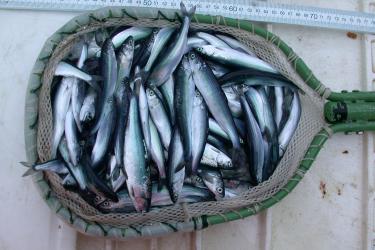When did you first realize you wanted to pursue a career in marine science?
I was a freshman in high school living in Utqiagvik (Barrow, Alaska). I happened upon a whale biologist, Craig George dissecting a whale taken in the annual Alaska Native community whale harvest. He spent time explaining what he was doing and sharing interesting factoids about different parts of the whale’s body. I just knew at that moment that marine biology was what I wanted to do. I ended up getting my undergraduate degree in marine biology and a Master’s degree in Fisheries Science.
Are you originally from Alaska?
No. I’m originally from west Texas, but I’ve lived all over the United States. I’ve been in Alaska for 15 years and have been lucky enough to live all over the state. My dad is a civil engineer whose work took us around the state from south-central, Norton Sound, and even in Utqiagvik for a few years. When I came to Juneau for school, my family was living in Palmer at the time.
What do you like about living in Alaska?
It is easy access to the outdoors. I enjoy fishing, hunting, hiking, and really any activity that gets me outside. Luckily in Alaska there is no shortage of these activities. Even though Alaska is so big, it still feels like a small town. There is a great sense of community.
What species do you study?
My interest is in studying salmon marine and freshwater survival. Salmon begin their lives in freshwater streams, lakes, and rivers and migrate to the sea as small fish called smolts. After they transition from fresh to salt water and grow into adults in the high seas of the North Pacific Ocean, they return to the place of their birth to spawn a new generation.
I like working on coho salmon the most because unlike some other salmon species in Alaska that can spend anywhere from 2 to 5 years at sea, Coho return to their natal river after just one year at sea. It makes it a lot easier to complete a research project in a shorter time frame.
Tell me about your internship with the Alaska Fisheries Science Center—how did that come about?
The Auke Creek Research Station has internship opportunities run through a partnership between the University of Alaska Southeast, and the Alaska Fisheries Science Center. In high school I was a member of the Alaska Native Science and Engineering Program. They connected me with my professor at the University of Alaska Southeast who offered me the internship opportunity at the Auke Creek fish weir. I started out working at the weir as a summer intern in 2013.
What do you like best about working at the weir?
It's a unique place to work. The weir has been in operation for over 40 years. It’s a great place to study salmon biology and genetics.
Scientists can monitor the daily juvenile out migration and adult returns for six anadromous fish species including pink, sockeye and coho salmon, and Dolly Varden char, and cutthroat and steelhead trout. So, a number of research projects have been conducted at the research station over the years. It exposes me to all kinds of research projects, which is fun.
There is also the added advantage of being able to conduct field research every day and still go home in the evening.
Can you describe a typical day at work?
I spend the mornings at the weir then head to the office in the afternoon to analyze results. I get the best of both worlds. Time in the office and time in the field every day.
What are you working on now?
We recently completed an eDNA study to produce actual abundance estimates. It’s exciting because we can compare our results with actual fish counts to ensure accuracy.
Can you explain how you get an abundance estimate from a water sample?
When a fish passes through the weir, it sheds cells containing genetic material unique to each fish. By analyzing that genetic material in the water samples, we can estimate how many individual fish passed through the weir at a given time.
What advice would you give someone who wants to get into the marine science profession?
Try to find yourself a good mentor and be willing to work hard to impress them. I wouldn’t be where I am today without the help of my mentors at University of Alaska and the Alaska Fisheries Science Center.





